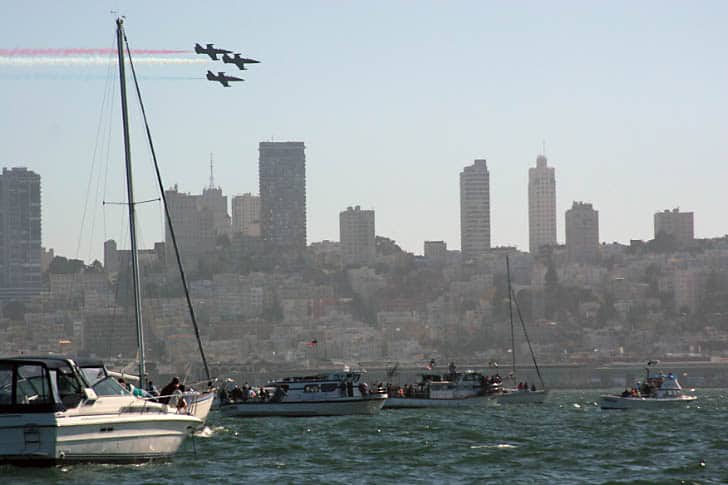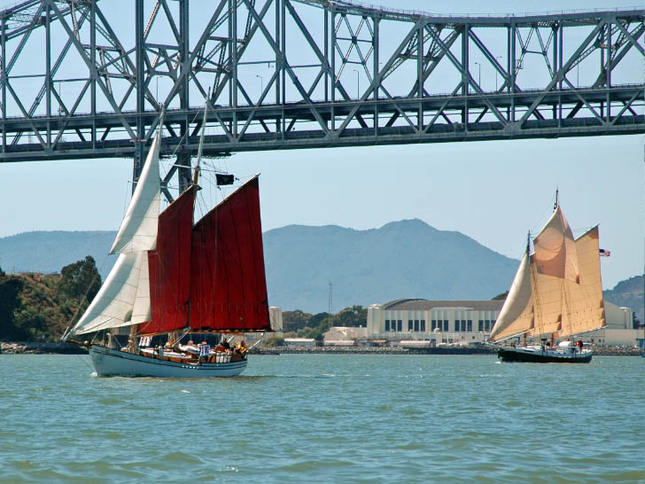The San Francisco Waterfront is an eclectic mix of marinas, commercial ship docks, and dozens of piers that are gradually being rebuilt to convert San Francisco’s historic waterfront into a destination for tourists and locals alike.
Pier 1 San Francisco
Pier 1, just north of the Ferry Building, is the largest San Francisco pier that has been converted to modern offices. There is a public walkway all around the long pier, providing excellent views of the ferries coming and going from the Ferry Building, the Bay Bridge, and Treasure Island. Immediately to the north of Pier 1 is the public guest dock at Pier 1-1/2.
Pier 27 San Francisco
Pier 27 was redeveloped to create a viewing area for the 2013 America’s Cup races, which was then transformed into a 91,000 square foot cruise ship terminal in 2014, named the James R. Herman Cruise Terminal.
Along the Embarcadero, a 2.5-acre area, formerly the home of Teatro ZinZanni and the west end of the Pier 27 shed, became a waterfront plaza.
Pier 29 San Francisco
Pier 29 was also redeveloped as part of the America’s Cup/Cruise Ship Terminal project.
Pier 39 San Francisco
Pier 39, at the northeast corner of San Francisco, is the largest tourist mecca on the San Francisco waterfront. Built in 1978, Pier 39 includes dozens of shops, more than a dozen restaurants, the Aquarium of the Bay, and a 300-slip marina.
San Francisco Ferry Building
Originally built in 1898, the 660-foot-long Ferry Building was a bustling place until the construction of the Bay Bridge and Golden Gate Bridge slashed ferry traffic. After decades of decline, an extensive restoration from 1999 through 2003 created the bustling Ferry Building Marketplace, which is now home to dozens of specialty food merchants and restaurants. It continues to serve as the hub for ferry traffic from around the bay.
The 245-foot clock tower at the center of the Ferry Building, modeled after a 12th century bell tower in the Seville Cathedral in Spain, anchors the bayside end of Market Street.
A 10-Acre Triangle on the Waterfront
Piers 27 and 29, at the foot of Battery and Lobard where they meet the Embarcadero, are unique in that they are at an angle to one another and are joined at the end to make a huge triangular area, 10 acres in all. Each pier was covered by a large maritime shed.
The shed on Pier 27 was demolished, and construction of the new James R. Herman cruise ship terminal was completed.
The northern edge of the triangle, occupied by Pier 29, was left partly intact to preserve the historic building, which dates back to 1915-1918. A June 2012 fire destroyed part of the building, but it is being restored.
Cruise Ship Terminal
The satellite photo on the left shows the Pier 27-29 area.
The long, dark vertical stripe is the old shed at Pier 27, now demolished.
The 1,358-foot berth can accommodate the largest visiting cruise ships.
It is designed to handle 2,600 passengers routinely, and up to 4,000 in a pinch.
Pier 35 will become the back-up berth when two ships are in the city at the same time.
San Francisco gets 40 to 80 cruise ships a year visiting the port.
When ships are not in port, the terminal will be available for other events.
SF Bay Events
There’s nothing like a fireworks show viewed from the water to conclude a great day on the bay.
We used to have two shows a year: the Fourth of July, of course, and the KFOG KaBoom! in May. Sadly, the KaBoom! is kaput.

Fleet Week, generally held in early October, is an opportunity to see Navy ships in the bay — along with nearly every other boat that moves, it seems.
If you’re not experienced with navigating in close quarters with hundreds of other boats, we recommend staying away from the crowded areas during all these events.

Opening Day is in late April.
Largely a holdover from places like the northeast where opening day really means something, in San Francisco it is mostly an excuse for everyone to take their boat out.
There is a boat parade and the Blessing of the Fleet by a priest on a Navy ship in Racoon Strait.

The annual Master Mariner’s Regatta brings out many of the beautiful wooden sailboats from around the bay.
There’s never a better chance to see the assortment of schooners and other wooden beauties.